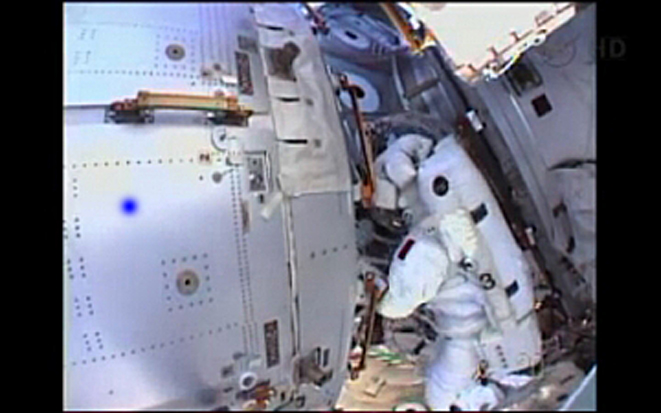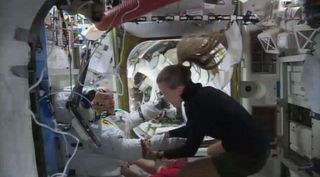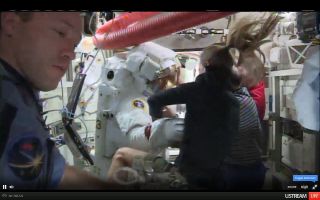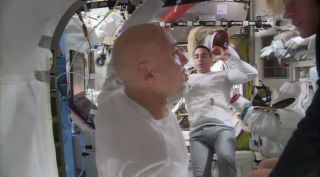NASA Cuts Spacewalk Short After Water Leak Inside Astronaut's Spacesuit

NASA aborted a planned six-hour spacewalk by two astronauts outside the International Space Station today (July 16) when one of the spacewalkers reported "a lot of water" inside his spacesuit helmet, a potentially scary situation.
European Space Agency astronaut Luca Parmitano reported that helmet started filling with water, making it difficult for him to continue the spacewalk outside of the International Space Station. The spacewalk ended after one hour and 32 minutes. It was supposed to last six hours and 15 minutes. The crew was in no immediate danger during the spacewalk, NASA officials said.

"There is some in my eyes, and some in my nose," Parmitano said. "It's a lot of water."[Photos: NASA Aborts Spacewalk After Spacesuit Water Leak ]
This is the second shortest spacewalk in history. The shortest — lasting only 14 minutes — happened in 2004 when astronaut Mike Fincke had a pressurization problem in his oxygen tank.
NASA astronaut Chris Cassidy and Parmitano began their spacewalk today at 7:57 a.m. EDT (1157 GMT). They wore NASA-issue spacesuits called Extravehicular Mobility Units, or EMUs. It ended at 9:29 a.m. EDT (1329 GMT).
Parmitano reported the water in his spacesuit about one hour and nine minutes into the spacewalk. The cause of the water leak isn't yet known, but the tasks scheduled for the spacewalk can be deferred until a later excursion, NASA officials said.

"[Mission Controllers on the ground] are taking the cautious path and ending the EVA early," a NASA spokesman said during a broadcast on NASA TV.
Get the Space.com Newsletter
Breaking space news, the latest updates on rocket launches, skywatching events and more!
NASA officials are expected to hold a news conference to discuss the aborted spacewalk later today.
Parmitano headed straight back to the U.S. Quest airlock on the International Space Station while Cassidy followed. Cassidy assured Parmitano repeatedly that he was close behind.
Once inside the airlock, the astronauts began repressurizing the chamber in order to return inside the station. At one point, Cassidy said it looked as if Parmitano could not hear any calls over his spacesuit radio.
"He looks fine," Cassidy said. "He looks miserable, but okay."

Today's spacewalk was the second in eight days for Parmitano and Cassidy. The two astronauts planned to continue work that will prepare the station for the arrival of a new Russian multipurpose laboratory module slated to arrive later this year, and perform other maintenance tasks.
This spacewalk is the 171st spacewalk in support of building the International Space Station, NASA officials said. This is the second spacewalk for Parmitano and the sixth for Cassidy. On July 9, Parmitano became the first Italian astronaut to walk in space.
Parmitano and Cassidy are joined on the space station by NASA's Karen Nyberg, Russian cosmonauts Fyodor Yurchikhin, Pavel Vinogradov and Alexander Misurkin. Together, they make up the orbiting laboratory's Expedition 36 crew .
The $100 billion International Space Station is the product of five space agencies representing 15 different countries. Rotating crews of astronauts have continually staffed the orbiting laboratory since 2000.
This story was updated on July 16 at 10:45 a.m. EDT (1445 GMT).
Follow Miriam Kramer @mirikramer and Google+. Follow us @Spacedotcom, Facebook and Google+. Original article on SPACE.com.
Join our Space Forums to keep talking space on the latest missions, night sky and more! And if you have a news tip, correction or comment, let us know at: community@space.com.

Miriam Kramer joined Space.com as a Staff Writer in December 2012. Since then, she has floated in weightlessness on a zero-gravity flight, felt the pull of 4-Gs in a trainer aircraft and watched rockets soar into space from Florida and Virginia. She also served as Space.com's lead space entertainment reporter, and enjoys all aspects of space news, astronomy and commercial spaceflight. Miriam has also presented space stories during live interviews with Fox News and other TV and radio outlets. She originally hails from Knoxville, Tennessee where she and her family would take trips to dark spots on the outskirts of town to watch meteor showers every year. She loves to travel and one day hopes to see the northern lights in person. Miriam is currently a space reporter with Axios, writing the Axios Space newsletter. You can follow Miriam on Twitter.